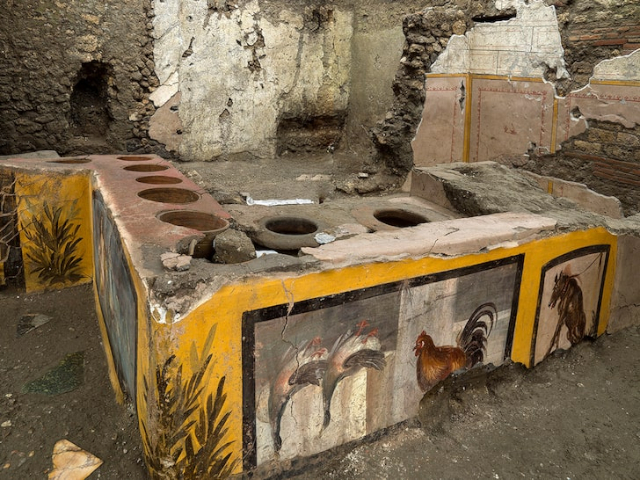Picture it… A beautiful Italian morning in 79 AD (now referred to as ‘CE’, or Current Era) in the city of Pompeii, just across the Bay of Naples from the city of that same name. Folks hurrying to work, fisher folk coming in from their early morning routine on the water. Commerce perking along as it always had…
 Pompeii Snack Bar c.79 AD
Pompeii Snack Bar c.79 AD
Then, without any warning that has been recorded for posterity, Mount Vesuvius, at whose base Pompeii stood, blew its top and the end of the city came quickly. It was, geologists say, an eruption very similar in character to that which saw Mount St. Helens lose its peak and one whole side in 1980. Millions of tonnes of super-hot volcanic ash and clouds of toxic gasses roared down the mountainside at speeds of up to 400 mph / 640 kmph. That’s known to scientists as a pyroclastic flow. The people of Pompeii never had a chance. All were stopped, entombed in ash where they fell, and lay there for 2,000 years before modern-day archeologists came to gently, carefully disinter them, trying to learn all they can about that last horrific day.
Lots of stuff to learn
Pompeii, in its relatively complete state of preservation, may be unique in the world as a window into the lives of the Ancient Romans. Even the smallest objects, or their impressions, are preserved in the powdery ash. But one of the most recent discoveries at the excavation is the remains of what may have been one of the oldest Fast Food joints known to history.
The small, kiosk-like shop was located on a small square with a fountain in its centre; a spot where scientists postulate that there was a lot of foot traffic. Just like the best spots for modern-day take-outs. There was even another such joint located just across the square – which makes me think of the situation today in which you’ll see several Fast Food and Coffee shops clustered round the best spots to catch peoples’ attention.
What was it like?
It was relatively small (no actual seating, apparently) and was ringed by what we’d call a bar or a diner counter. In the counter top were clusters of holes at intervals, which excavators believe held clay cooking/serving vessels; like soup and stew tureens at salad bars or buffet steam tables today. At the back, large cooking kettles for preparing bulk amounts of food. Against the back wall, amphorae – large terracotta jugs used for transporting and storing foods (particularly Olive Oil) in bulk. Little different, really, than what you’d see at a Fast Food joint today, in concept at least.
What were they eating?
Well-preserved remains of duck bones were found in the bottom of one cooking pot. Remains of goats, pigs, fish and snails were found in others. That was what average people were eating on a routine day at that time. Not unlike Burgers and Fries and other convenient foods in our time. What strikes me is, the Pompeians were eating a great variety of more-nutritious foods than we commonly eat today. Did I hear somebody mutter something about the Mediterranean Diet?
Never the less…
In one street, you can clearly see the imprint of a man, his elbows cocked, and his fists on his hips, probably staring up the mountain and shaking his head.
“Cursed be the Small Gods!’ he might have been saying, to nobody in particular. “I just washed the d****d Chariot!”
But that would have been the last thing he ever thought. You can’t outrun a pyroclastic flow…
~ Maggie J.

